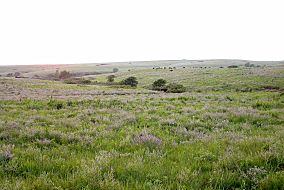Konza Prairie Biological Station facts for kids
Quick facts for kids Konza Prairie |
|
|---|---|

Konza in spring with herd of bison in distance
|
|

USGS topographic map of Konza Prairie
|
|
| Location | 10 km (6.2 mi.) south of Manhattan, Kansas, Geary County, Flint Hills, Kansas, United States |
| Area | 34.9 km2 (13.5 sq mi) |
| Elevation | 330 m (1,080 ft) |
| Established | 1971 |
| Operator | The Nature Conservancy, Kansas State University |
| Website | Konza Prairie Biological Station |
The Konza Prairie Biological Station is a large natural area in northeastern Kansas. It covers about 3,487 hectares (8,616 acres) of land. This special place protects a type of grassland called tallgrass prairie. It is located in the Flint Hills region, south of Manhattan, Kansas. You can find a nice viewpoint along K-177 on its eastern side. The name "Konza" comes from the Kansa or Kaw Indians. They lived in this area many years ago.
The Konza Prairie is owned by The Nature Conservancy and Kansas State University. The university's Division of Biology uses it as a place for scientific research. Scientists study the environment here. It is part of a group of research sites called the Long Term Ecological Research Network. Konza Prairie was once a UNESCO biosphere reserve, which means it was recognized for its unique natural environment.
Contents
What is Konza Prairie?
Konza Prairie is a huge area of natural grassland. It is one of the largest remaining areas of unplowed tallgrass prairie in North America. This means the land has never been farmed. It looks much like it did hundreds of years ago.
Climate and Landscape
The weather at Konza Prairie changes a lot. Summers are warm and wet, while winters are dry and cold. Enough rain falls to support trees, but natural events keep the area mostly grassland. Drought, fire, and animals eating plants are important for keeping the prairie healthy.
The land here is not flat. It has hills and valleys, with elevations from about 320 to 444 meters (1,050 to 1,457 feet). Besides tallgrass prairie, you can find other natural areas. These include forests, wet claypan areas, shrublands, and areas along rivers (riparian communities). You can also see Limestone rocks sticking out of the ground.
Amazing Plants and Animals
Konza Prairie is home to many different kinds of living things. It has a rich variety of plants and animals.
Plant Life
Scientists have found 576 different types of vascular plants here. These are plants with special tissues to carry water and nutrients. They include many kinds of grasses and wildflowers.
Animal Life
The prairie supports a wide range of animals. There are 31 different kinds of mammals. You might see white-tailed deer and wild turkey. There are also 208 types of birds that live here or visit. You can find 34 kinds of reptiles and amphibians, and 20 kinds of fish. Plus, there are over 700 types of invertebrates, like insects.
Bison Herd
A special part of Konza Prairie is its herd of about 300 American bison. These large animals are very important to the prairie. They help keep the grassland healthy by grazing. Their grazing helps different plants grow and creates diverse habitats.
Visiting Konza Prairie
You can visit parts of the Konza Prairie. There are three hiking trails that visitors can use. These trails are different lengths: about 2.6 miles, 4.5 miles, and 6 miles. They offer a great way to see the prairie up close.
Images for kids




